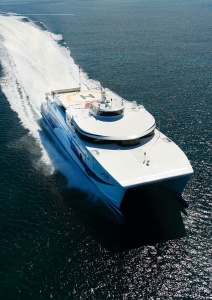National Ferries Company builds a better Oman

From operating the fastest ferries in the world to doubling passenger numbers, there is a real sense of momentum at Oman National Ferries.
Owned by the Sultanate of Oman’s government, NFC routes connect Khasab to Lima in the northern Musandam peninsula exclave, and Khasab to Muscat and Shinas, as well as a southern route between the Halaniyat islands and Salalah.
For a company that only began in 2008 it has grown quickly.
Taking over a government-run a cargo service on the Salalah to the Halaniyat islands route in 2008 using a landing craft, the operator swiftly added the Muscat to Khasab passenger itinerary following the delivery of two 65m high speed catamarans, Shinas and Hormuz, from Australia’s Austal Shipyard that same year.
In fact these ships are the fastest diesel-powered vehicle passenger ferries in the world, with Shinas reaching a record 56.6 knots on passage to Muscat in November 2011.
The vessels are powered by four MTU 20-cylinder 1163 series diesel engines each producing 6,500kW and driving a Rolls-Royce Kamewa waterjet via a Reintjes VLJ 4431 K71 gearbox.
The high speed helps to reduce the journey time for passengers on the long 230nm Muscat to Khasab route.
“Passengers can complete a journey on this route in five hours, as opposed to a six to seven hour journey by car,” explained said NFC head of marketing and communication, Ghazi Al Zadjali.
“It is a direct route without having to go through border checks and formalities.”
Part of the United Arab Emirates sits between the Musandam peninsula and the rest of mainland Oman.
In May this year, Shinas was redeployed on a new route from Khasab to Shinas, again quite a long voyage at 125nm.
NFC also inaugurated a new terminal at Shinas for the new route. This followed the establishment of a shorter route solely on the Musandam peninsula, between Khasab and Lima, in July 2011.
This crossing is served by the 52m wave- piercing catamaran Sawqrah, which was delivered from Italian yard Rodriquez Cantieri Navale. Spear Green Design of Australia designed the vessel, the first in a series of three.
Sisterships Al Hallaniyat and Masirah are due to bolster this service in 2013.
The expansion does not stop there.
Next year will see two conventional passenger and car ferries delivered to serve another new route, this time from Masirah Island to Shannah on the central coast. NFC is in the process of contracting Strategic Marine’s Vietnam branch to build the double- ended pair.
The 45m aluminium ferries will be able to transport 150 passengers and 30 cars each. Once these enter service, NFC will have a total of eight vessels on five routes.
Al Zadjali commented: “The future plan is to provide services from 14 ports along the coastline of Oman and also to establish an international run from northern ports.”
On the subject of route conditions he added: “Weather conditions prevalent at certain times of the year are challenging for us. Sometimes we have to restrict or cancel sailings to ensure comfortable journeys for our passengers.”
Passenger numbers are on a continuous upward trend. In 2010, NFC carried 10,616 people overall, and in 2011 this rose to 19,820. In 2012 there were 34,782 passengers carried, which represents a 75 per cent increase compared with the last year.
“Commencing vehicle carriage on our fast ferries contributed to the increase in throughput,” added Al Zadjali.
“Through better media coverage, adverts and our marketing effort, awareness of our service has increased over time too.
“The year-on-year increase in passenger numbers is a good indication of our growth since our inception - we have built the concept of Omani citizens using ferries for transportation.”
Passengers have the choice of three different classes of seating: tourist, business and first class.
“Our vessels are very convenient and comfortable for our passengers,” said Al Zadjali. “We provide meals and drinks continuously throughout each sailing.” NFC uses local shipyards where possible for its vessel maintenance, but also utilises regional shipyards in the Arabian Gulf area.
The operator follows a stringent maintenance programme with annual dry dockings.”
NFC is investing in new technologies as well. Satellite communication services, providing TV and internet, are available on some of the vessels.
One ferry has been equipped with Wi-Fi services and there are plans to roll this out to the rest of the fleet.
The Sultanate of Oman has specified that the number of native Omanis working in government service should be 84 per cent of the workforce, as part of its ‘Omanisation’ policy.
NFC is working towards this with its crew recruitment programme but currently the figure stands at 58 per cent. Its crews are supplemented with European and Filipino seafarers.
Al Zadjali commented: “Finding qualified seafarers is always a challenge, particularly recruiting those with experience of high speed ferries. At this point in time we outsource most of our training requirements.”
According to Al Zadjali, NFC is proud to be the national marine transporter of Oman. “Our fast ferry service is unique in the Middle East and North Africa region,” he said.
World Travel Awards
The Oman National Ferries Company won the World Travel Awards World’s Leading Sustainable Tourism Award in 2012, recognising its efforts in protecting the marine environment and supporting regional development.
Al Zadjali added: “NFC plays a major role in social responsibility, providing services to remote villages by operating one of the longest non-stop domestic routes in the world, exceeding 320nm.
We also implement corporate social responsibility by sponsoring social events or by giving exclusive trips on our ferries for particular organisations.
Moreover, we recruit the younger Omani generation to participate in building the country.”

